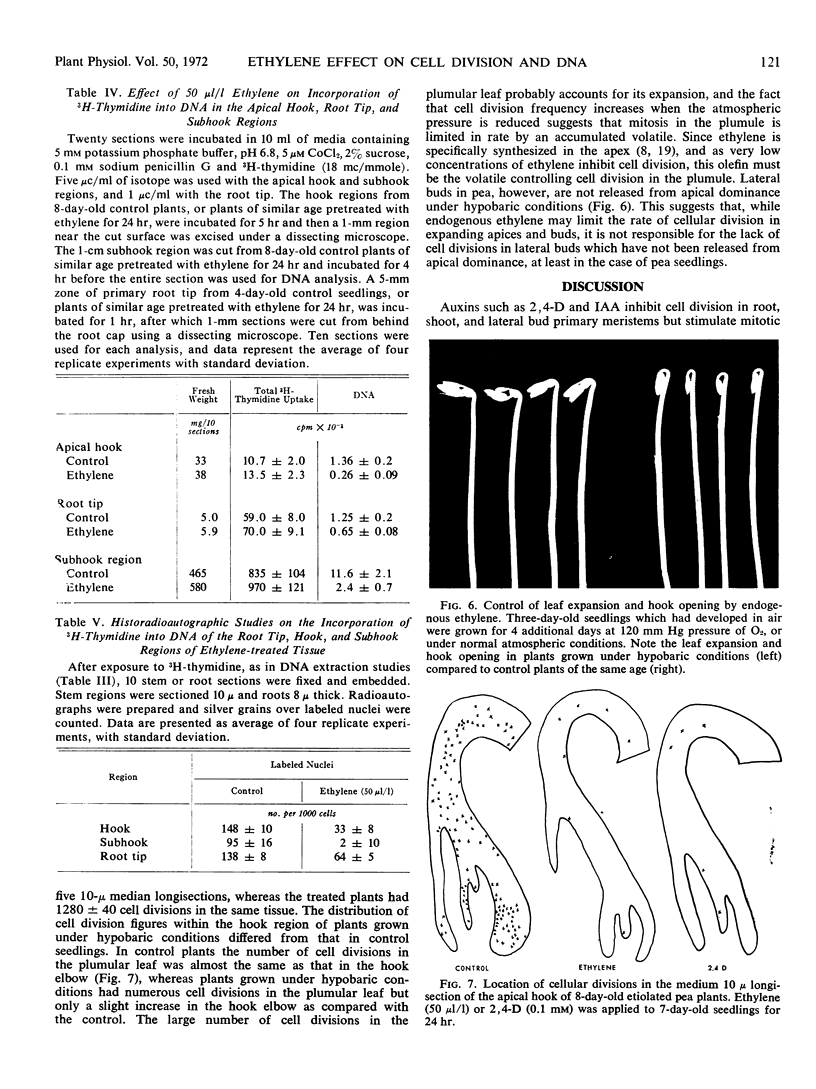Abstract
Ethylene and supraoptimal levels of 2,4-dichlorophenoxyacetic acid inhibit the growth of the apical hook region of etiolated Pisum sativum (var. Alaska) seedlings by stopping almost all cell divisions. Cells are prevented from entering prophase. The hormones also retard cell division in intact root tips and completely stop the process in lateral buds. The latter inhibition is reversed partially by benzyl adenine. In root tips and the stem plumular and subhook regions, ethylene inhibits DNA synthesis. The magnitude of this inhibition is correlated with the degree of repression of cell division in meristematic tissue, suggesting that the effect on cell division results from a lack of DNA synthesis. Ethylene inhibits cell division within a few hours with a dose-response curve similar to that for most other actions of the gas. Experiments with seedlings grown under hypobaric conditions suggest that the gas naturally controls plumular expansion and cell division in the apical region.
Full text
PDF







Images in this article
Selected References
These references are in PubMed. This may not be the complete list of references from this article.
- Abeles F. B., Rubinstein B. Regulation of Ethylene Evolution and Leaf Abscission by Auxin. Plant Physiol. 1964 Nov;39(6):963–969. doi: 10.1104/pp.39.6.963. [DOI] [PMC free article] [PubMed] [Google Scholar]
- Apelbaum A., Burg S. P. Effects of Ethylene and 2,4-Dichlorophenoxyacetic Acid on Cellular Expansion in Pisum sativum. Plant Physiol. 1972 Jul;50(1):125–131. doi: 10.1104/pp.50.1.125. [DOI] [PMC free article] [PubMed] [Google Scholar]
- Burg S. P., Burg E. A. Ethylene formation in pea seedlings; its relation to the inhibition of bud growth caused by indole-3-acetic Acid. Plant Physiol. 1968 Jul;43(7):1069–1074. doi: 10.1104/pp.43.7.1069. [DOI] [PMC free article] [PubMed] [Google Scholar]
- Burg S. P., Burg E. A. Fruit storage at subatmospheric pressures. Science. 1966 Jul 15;153(3733):314–315. doi: 10.1126/science.153.3733.314. [DOI] [PubMed] [Google Scholar]
- Burg S. P., Burg E. A. Inhibition of polar auxin transport by ethylene. Plant Physiol. 1967 Sep;42(9):1224–1228. doi: 10.1104/pp.42.9.1224. [DOI] [PMC free article] [PubMed] [Google Scholar]
- Burg S. P., Burg E. A. The interaction between auxin and ethylene and its role in plant growth. Proc Natl Acad Sci U S A. 1966 Feb;55(2):262–269. doi: 10.1073/pnas.55.2.262. [DOI] [PMC free article] [PubMed] [Google Scholar]
- Burg S. P. Ethylene, plant senescence and abscission. Plant Physiol. 1968 Sep;43(9 Pt B):1503–1511. [PMC free article] [PubMed] [Google Scholar]
- Chadwick A. V., Burg S. P. An explanation of the inhibition of root growth caused by indole-3-acetic Acid. Plant Physiol. 1967 Mar;42(3):415–420. doi: 10.1104/pp.42.3.415. [DOI] [PMC free article] [PubMed] [Google Scholar]
- Chadwick A. V., Burg S. P. Regulation of root growth by auxin-ethylene interaction. Plant Physiol. 1970 Feb;45(2):192–200. doi: 10.1104/pp.45.2.192. [DOI] [PMC free article] [PubMed] [Google Scholar]
- Davidson D., MacLeod R. D. Changes in mitotic indices in roots of Vicia faba. I. Antagonistic effect of colchicine and IAA. Chromosoma. 1966;18(3):421–437. doi: 10.1007/BF00332546. [DOI] [PubMed] [Google Scholar]
- Fan D. F., Maclachlan G. A. Massive synthesis of ribonucleic Acid and cellulase in the pea epicotyl in response to indoleacetic Acid, with and without concurrent cell division. Plant Physiol. 1967 Aug;42(8):1114–1122. doi: 10.1104/pp.42.8.1114. [DOI] [PMC free article] [PubMed] [Google Scholar]
- Goeschl J. D., Pratt H. K., Bonner B. A. An effect of light on the production of ethylene and the growth of the plumular portion of etiolated pea seedlings. Plant Physiol. 1967 Aug;42(8):1077–1080. doi: 10.1104/pp.42.8.1077. [DOI] [PMC free article] [PubMed] [Google Scholar]
- Holm R. E., O'brien T. J., Key J. L., Cherry J. H. The Influence of Auxin and Ethylene on Chromatin-directed Ribonucleic Acid Synthesis in Soybean Hypocotyl. Plant Physiol. 1970 Jan;45(1):41–45. doi: 10.1104/pp.45.1.41. [DOI] [PMC free article] [PubMed] [Google Scholar]
- Kang B. G., Yocum C. S., Burg S. P., Ray P. M. Ethylene and carbon dioxide: mediation of hypocotyl hook-opening response. Science. 1967 May 19;156(3777):958–959. doi: 10.1126/science.156.3777.958. [DOI] [PubMed] [Google Scholar]
- Larue T. A., Gamborg O. L. Ethylene Production by Plant Cell Cultures: Variations in Production during Growing Cycle and in Different Plant Species. Plant Physiol. 1971 Oct;48(4):394–398. doi: 10.1104/pp.48.4.394. [DOI] [PMC free article] [PubMed] [Google Scholar]
- Maxie E. C., Crane J. C. 2,4,5-trichlorophenoxyacetic Acid: effect on ethylene production by fruits and leaves of fig tree. Science. 1967 Mar 24;155(3769):1548–1550. doi: 10.1126/science.155.3769.1548. [DOI] [PubMed] [Google Scholar]
- Morgan P. W., Gausman H. W. Effects of ethylene on auxin transport. Plant Physiol. 1966 Jan;41(1):45–52. doi: 10.1104/pp.41.1.45. [DOI] [PMC free article] [PubMed] [Google Scholar]
- Radin J. W., Loomis R. S. Ethylene and carbon dioxide in the growth and development of cultured radish roots. Plant Physiol. 1969 Nov;44(11):1584–1589. doi: 10.1104/pp.44.11.1584. [DOI] [PMC free article] [PubMed] [Google Scholar]




